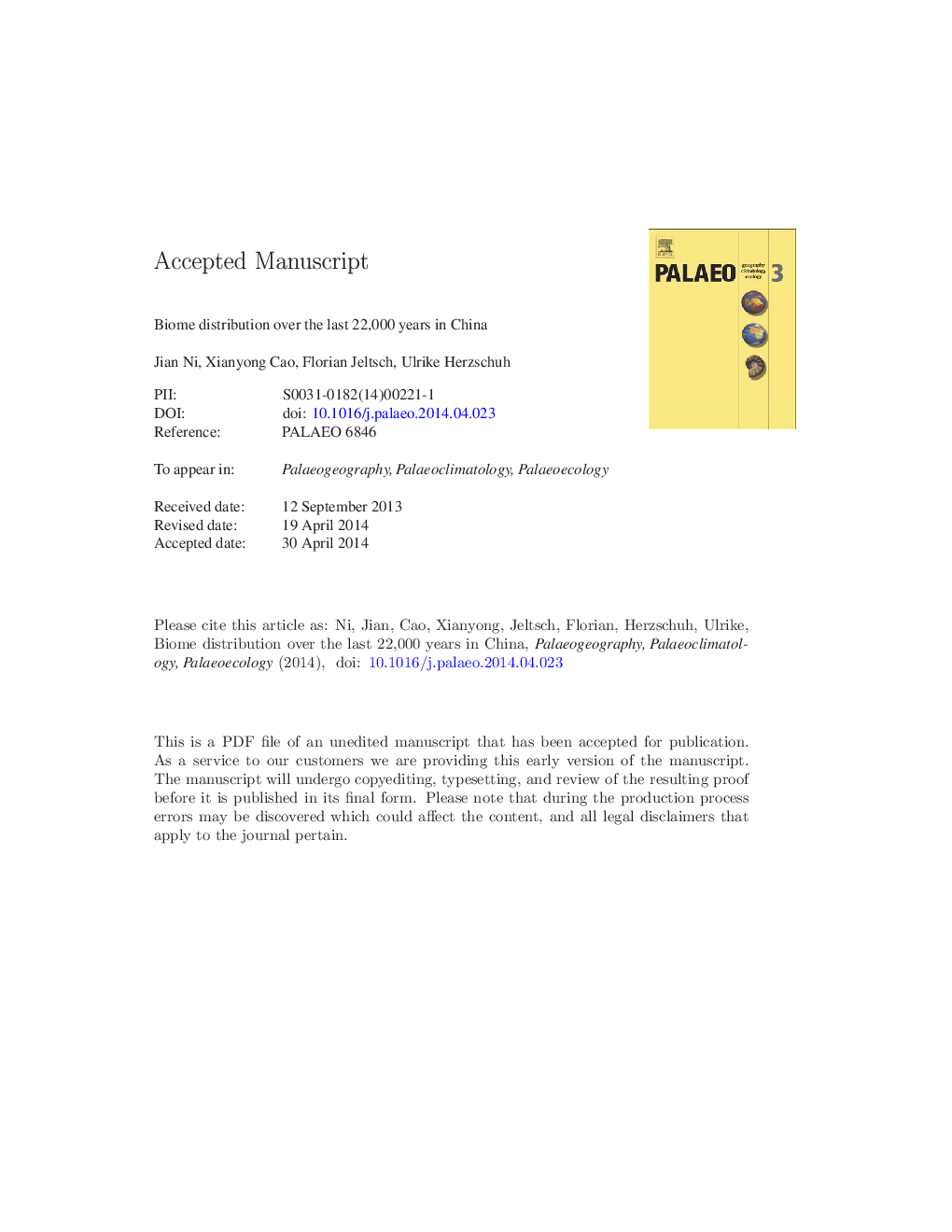| کد مقاله | کد نشریه | سال انتشار | مقاله انگلیسی | نسخه تمام متن |
|---|---|---|---|---|
| 6350080 | 1622181 | 2014 | 42 صفحه PDF | دانلود رایگان |
عنوان انگلیسی مقاله ISI
Biome distribution over the last 22,000Â yr in China
دانلود مقاله + سفارش ترجمه
دانلود مقاله ISI انگلیسی
رایگان برای ایرانیان
کلمات کلیدی
موضوعات مرتبط
مهندسی و علوم پایه
علوم زمین و سیارات
فرآیندهای سطح زمین
پیش نمایش صفحه اول مقاله

چکیده انگلیسی
Patterns of past vegetation changes over time and space can help facilitate better understanding of the interactions among climate, ecosystem, and human impact. Biome changes in China over the last 22,000Â yr (calibrated radiocarbon date, a BP) were numerically reconstructed by using a standard approach of pollen-plant functional type-biome assignment (biomization). The biomization procedure involves pollen data from 2434 surface sites and 228 fossil sites with a high quality of pollen count and 14C dating, 51 natural and three anthropogenic plant functional types (PFTs), as well as 19 natural and one anthropogenic biome. Surface pollen-based reconstruction of modern natural biome patterns is in good agreement (74.4%) with actual vegetation distribution in China. However, modern large-scale anthropogenic biome reconstruction has not been successful based on the current setup of three anthropogenic PFTs (plantation, secondary, and disturbed PFT) because of the limitation of non-species level pollen identification and the difficulty in the clear assignment of disturbed PFTs. The non-anthropogenic biome distributions of 44 time slices at 500-year intervals show large-scale discrepant and changed vegetation patterns from the last glacial maximum (LGM) to the Holocene throughout China. From 22Â ka BP to 19Â ka BP, temperate grassland, xerophytic shrubland, and desert dominated northern China, whereas cold or cool forests flourished in central China. Warm-temperate evergreen forests were restricted to far southern China, and tropical forests were absent. During 18.5Â ka BP to 12Â ka BP, cold, cool, and dry biomes extended to some parts of northern, western, and eastern China. Warm-temperate evergreen and mixed forests gradually expanded to occupy the whole of southern China. A slight northward shift of forest biomes occurred from 15Â ka BP to 12Â ka BP. During 11.5Â ka BP to 9Â ka BP, temperate grassland and shrubland gradually stretched to northern and western China. Cold and cool forests widely expanded into northern and central China, as well as in the northern margin of South China along with temperate deciduous forest. Since the early mid-Holocene (approximately 8.5Â ka BP to 5.5Â ka BP), all forest biomes shifted northward at the expense of herbaceous and shrubby biomes. Simultaneously, cold and cool forest biomes occupied the marginal areas of the Tibetan Plateau and the high mountains in western China. During the middle to late Holocene, from 5Â ka to the present, temperate grassland and xerophytic shrubland expanded to the south and east, whereas temperate deciduous forests slightly shifted southward. After 3Â ka BP, forest biomes were absent in western China and on the Tibetan plateau surface. Dramatic biome shifts from the LGM to the Holocene were observed in the forest-grassland ecotone and transitional zones between temperate and subtropical climates, between subtropical and tropical regions, and in the mountainous margins of the eastern Tibetan Plateau. Evidence showed more human disturbances during the late Holocene. More pollen records and historical documents are therefore further needed to understand fully the human disturbance-induced large-scale forest changes. In addition, more classifications of anthropogenic biome or land cover, more distinct assignment of pollen taxa to anthropogenic PFTs, and more effective numerical and/or mechanistic techniques in building large-scale human disturbances are required.
ناشر
Database: Elsevier - ScienceDirect (ساینس دایرکت)
Journal: Palaeogeography, Palaeoclimatology, Palaeoecology - Volume 409, 1 September 2014, Pages 33-47
Journal: Palaeogeography, Palaeoclimatology, Palaeoecology - Volume 409, 1 September 2014, Pages 33-47
نویسندگان
Jian Ni, Xianyong Cao, Florian Jeltsch, Ulrike Herzschuh,